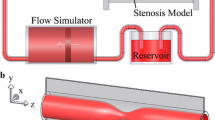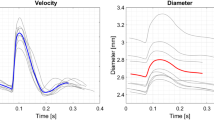Abstract
Echo particle image velocimetry (Echo PIV) presents itself as an attractive in vivo flow quantification technique to traditional approaches. Promising results have been acquired; however, limited quantification and validation is available for post-stenotic flows. We focus here on the comprehensive evaluation of in vitro downstream stenotic flow quantified by Echo PIV and validated in relation to digital particle image velocimetry (DPIV). A Newtonian blood analog was circulated through a closed flow loop and quantified immediately downstream of a 50 % axisymmetric blockage at two Reynolds numbers (Re) using time-averaged Echo PIV and DPIV. Centerline velocities were in good agreement at all Re; however, Echo PIV measurements presented with elevated standard deviation (SD) at all measurements points. SD was improved using increased line density (LD); however, frame rate or field of view (FOV) is compromised. Radial velocity profiles showed close agreement with DPIV with the largest disparity in the shear layer and near-wall recirculation. Downstream recirculation zones were resolved by Echo PIV at both Re; however, magnitude and spatial coverage was reduced compared to DPIV that coincided with reduced contrast agent penetration beyond the shear layer. Our findings support the use of increased LD at a cost to FOV and highlight reduced microbubble penetration beyond the shear layer. High local SD at near-wall measurements suggests that further refinement is required before proceeding to in vivo quantification studies of wall shear stress in complex flow environments.












Similar content being viewed by others

References
Ahmed SA, Giddens DP (1983) Velocity measurements in steady flow through axisymmetric stenoses at moderate Reynolds numbers. J Biomech 16:505–516
Becher H, Burns PN (2000) Handbook of contrast echocardiography: left ventricular function and myocardial perfusion. Springer
Berger SA, Jou L-D (2000) Flows in stenotic vessels. Annu Rev Fluid Mech 32:347–382
Beulen B, Bijnens N, Rutten M, Brands P, van de Vosse F (2010a) Perpendicular ultrasound velocity measurements by 2D cross-correlation of RF data. Part A: validation in a straight tube. Exp Fluids 49:1177–1186
Beulen B, Bijnens N, Rutten M, Brands P, van de Vosse F (2010b) Perpendicular ultrasound velocity measurements by 2D cross-correlation of RF data. Part B: volume flow estimation in curved vessels. Exp Fluids 49:1219–1229
Bluestein D, Gutierrez C, Londono M, Schoephoerster RT (1999) Vortex shedding in steady flow through a model of an arterial stenosis and its relevance to mural platelet deposition. Ann Biomed Eng 27:763–773
Bohs LN, Frimel BH, Trahey GE (1995) Experimental velocity profiles and volumetric flow via two-dimensional speckle tracking. Ultrasound Med Biol 21:885–898
Bohs LN, Geiman BJ, Anderson ME, Gebbart SC, Trahey GE (2000) Speckle tracking for multi-dimensional flow estimation. Ultrasonics 38:369–375
Choi HW, Barakat AI (2005) Numerical study of the impact of non-Newtonian blood behavior on flow over a two-dimensional backward facing step. Biorheology 42:493–509
Crowe CT, Troutt TR, Chung JN (1995) Particle interactions with vortices. In: Green SI (ed) Fluid vortices. Kluwer Academic Publishers, Dordrecht, pp 829–861
Curry TS, Dowdey JE, Murry RC Jr (1990) Christensen’s physics of diagnostic radiology. Lippincott Williams and Wilkins, Philadelphia
de Jong N, Bouakaz A, Ten Cate FJ (2002) Contrast harmonic imaging. Ultrasonics 40:567–573
Dobson G, Maher N, Petrasek P, Johnston C (2007) Diastolic rotational flow in the aortic arch. Can J Anesth 54:1017–1018
Dobson G, Johnston CR, Walker A (2009) Strut-induced flow separation in an endostent. Can J Anesth 56:257–258
Durst F, Ray S, Ünsal B, Bayoumi A (2005) The development lengths of laminar pipe and channel flow. J Fluids Eng 127:1154–1160
Eckstein EC, Bailey DG, Shapiro AH (1977) Self-diffusion of particles in shear flow of a suspension. J Fluid Mech 79:191–208
Hochareon P, Manning KB, Fontaine AA, Tarbell JM, Deutsch S (2004) Wall shear-rate estimation within the 50 cc Penn State artificial heart using particle image velocimetry. J Biomech Eng 126:431–437
Hong G-R, Pedrizzetti G, Tonti G, Li P, Wei Z, Kim JK, Baweja A, Liu S, Chung N, Houle H, Narula J, Vannan MA (2008) Characterization and quantification of vortex flow in the human left ventricle by contrast echocardiography using vector particle image velocimetry. JACC Cardiovasc Imaging 1:705–717
Hur SC, Henderson-MacLennan NK, McCabe ERB, Di Carol D (2011) Deformability-based cell classification and enrichment using inertial microfluidics. Lab Chip 11:912–920
Kähler CJ, McKenna R, Scholz U (2005) Wall-shear-stress measurements at moderated Re-numbers with single pixel resolution using long distance μ-PIV: an accuracy assessment. Pasadena CA, USA: 6th International Symposium on Particle Image Velocimetry. pp 1–12
Kähler CJ, Scholz U, Ortmanns J (2006) Wall-shear-stress and near-wall turbulence measurements up to single pixel resolution by means of long-distance micro-PIV. Exp Fluids 41:327–341
Kheradvar A, Houle H, Pedrizzetti G, Tonti G, Belcik T, Ashraf M, Lindner JR, Gharib M, Sahn D (2010) Echocardiographic particle image velocimetry: a novel technique for quantification of left ventricular blood vorticity pattern. J Am Soc Echocardiogr 23:86–94
Kim HB, Hertzberg J, Lanning C, Shandas R (2004a) Noninvasive measurements of steady and pulsating velocity profiles and shear rates in arteries using echo PIV: In vitro validation studies. Ann Biomed Eng 32:1067–1076
Kim HB, Hertzberg JR, Shandas R (2004b) Development and validation of echo PIV. Exp Fluids 36:455–462
Ku D (1997) Blood flow in arteries. Annu Rev Fluid Mech 29:399–434
Lecuona A, Ruiz-Rivas U, Nogueira J (2002) Simulation of particle trajectories in a vortex-induced flow: application to seed-dependent flow measurement. Meas Sci Technol 13:1020–1028
Liu L, Zheng H, Williams L, Zhang F, Wang R, Hertzberg J, Shandas R (2008) Development of a custom-designed echo particle image velocimetry system for multi-component hemodynamic measurements: system characterization and initial experimental results. Phys Med Biol 53:1397–1412
Lou Z, Wang W-J, Stein PD (1993) Errors in the estimation of arterial wall shear rates that result from curve fitting of velocity profiles. J Biomech 26:383–390
Malek AM, Alper SL, Izumo S (1999) Hemodynamic shear stress and its role in atherosclerosis. JAMA 282:2035–2042
Melling A (1997) Tracer particles and seeding for particle image velocimetry. Meas Sci Technol 8:1406–1416
Merzkirch W (1987) Flow visualization. Academic Press Inc., London
Meunier P, Leweke T (2003) Analysis and treatment of errors due to high velocity gradients in particle image velocimetry. Exp Fluids 35:408–421
Moore JE Jr, Ku DN, Zarins CK, Glagov S (1992) Pulsatile flow visualization in the abdominal aorta under differing physiological conditions: implications for increased susceptibility to atherosclerosis. J Biomech Eng 114:391–397
Niu L, Qian M, Wan K, Yu W, Jin Q, Ling T, Gao S, Zheng H (2010) Ultrasonic particle image velocimetry for improved flow gradient imaging: algorithms, methodology and validation. Phys Med Biol 55:2103–2120
Niu L, Qian M, Yan L, Yu W, Jiang B, Jin Q, Wang Y, Shandas R, Liu X, Zheng H (2011) Real-time texture analysis for identifying optimum microbubble concentration in 2-D ultrasonic particle image velocimetry. Ultrasound Med and Biol 37:1280–1291
Peterson SD, Plesniak MW (2008) The influence of inlet velocity profile and secondary flow on pulsatile flow in a model artery with stenosis. J Fluid Mech 616:263–301
Poelma C, Mari JM, Foin N, Tang M-X, Krams R, Caro CG, Weinberg PD, Westerweel J (2011) 3D flow reconstruction using ultrasound PIV. Exp Fluids 50:777–785
Poelma C, van der Mijle RME, Mari JM, Tang M-X, Weinberg PD, Westerweel J (2012) Ultrasound imaging velocimetry: toward reliable wall shear stress measurements. Eur J Mech B/Fluids 35:70–75
Qian M, Niu L, Wang Y, Jiang B, Jin Q, Jiang C, Zheng H (2010) Measurement of flow velocity fields in small vessel-mimic phantoms and vessels of small animals using micro ultrasonic particle image velocimetry. Phys Med Biol 55:6069–6088
Qian M, Song R, Niu L, Chen L, Zheng H (2011) Two-dimensional flow study in a stenotic artery phantom using ultrasonic particle image velocimetry. Boston, MA, USA: 33rd Annual International Conference of the IEEE EMBS, pp 563–566
Raffel M, Willert C, Wereley S, Kompenhans J (2007) Particle image velocimetry: a practical guide. Springer, Berlin
Schirmer CM, Malek AM (2007) Wall shear stress gradient analysis within an idealized stenosis using non-Newtonian flow. Neurosurgery 61:855–864
Sengupta PP, Khandheria BK, Korinek J, Jahangir A, Yoshifuku S, Milosevic I, Belohlavek M (2007) Left ventricular isovolumic flow sequence during sinus and paced rhythms: new insights from use of high-resolution Doppler and ultrasonic digital particle image velocimetry. J Am Coll Cardiol 49:899–908
Son SY, Kihm KD, Han J-C (2002) PIV flow measurements for heat transfer characterization in two-pass square channels with smooth and 90° ribbed walls. Int J Heat Mass Transfer 45:4809–4822
Stroud JS, Berger SA, Saloner D (2002) Numerical analysis of flow through a severely stenotic carotid artery bifurcation. J Biomech Eng 124:9–20
Theunissen R, Scarano F, Riethmuller ML (2007) An adaptive sampling and windowing interrogation method in PIV. Meas Sci Technol 18:275–287
Tropea C, Yarin AL, Foss JF (2007) Springer handbook of experimental fluids mechanics. Springer, Berlin
Udesen J, Gran F, Hansen KL, Jensen JA, Thomsen C, Nielsen MB (2008) High frame-rate blood vector velocity imaging using plane waves: simulations and preliminary experiments. IEEE Trans Ultrason Ferroelectr Freq Control 55:1729–1743
Varghese SS, Frankel SH (2003) Numerical modeling of pulsatile turbulent flow in stenotic vessels. J Biomech Eng 125:445–460
Walburn FJ, Sabbah HN, Stein PD (1981) Flow visualization in a mold of an atherosclerotic human abdominal aorta. J Biomech Eng 103:168–170
Walker AM, Johnston CR, Rival DE (2012) The quantification of hemodynamic parameters downstream of a Gianturco zenith stent wire using Newtonian and non-Newtonian analog fluids in a pulsatile flow environment. J Biomech Eng 134:111001
Wootton DM, Ku DN (1999) Fluid mechanics of vascular systems, diseases, and thrombosis. Annu Rev Biomed Eng 1:299–329
Xiong FL, Chong CK (2007) PIV-validated numerical modeling of pulsatile flows in distal coronary end-to-side anastomoses. J Biomech 40:2872–2881
Young DF, Munson BR, Okiishi TH, Huebsch WW (2007) A very brief introduction to fluid mechanics, 4th edn. Wiley, Hoboken
Zhang F, Lanning C, Mazzaro L, Rech B, Chen J, Chen SJ, Shandas R (2008) Systematic validation of echo particle image velocimetry technique using a patient-specific carotid bifurcation model. Beijing, China: 2008 IEEE International Ultrasonics Symposium, pp 9–12
Zhang F, Lanning C, Mazzaro L, Barker AJ, Gates PE, Strain WD, Fulford J, Gosling OE, Shore AC, Bellenger NG, Rech B, Chen J, Chen J, Shandas R (2011) In vitro and preliminary in vivo validation of echo particle image velocimetry in carotid vascular imaging. Ultrasound Med Biol 37:450–464
Zheng H, Liu L, Williams L, Hertzberg JR, Lanning C, Shandas R (2006) Real time multicomponent echo particle image velocimetry technique for opaque flow imaging. Appl Phys Lett 88:261915
Zhu H, Qian M, Zou Y, Song R, Niu L, Jiang B, Guang Q, Zheng H (2011) The validation of Echo-PIV technique used in a stenosis model. Wuhan, China: the 5th International Conference on Bioinformatics and Biomedical Engineering (ICBBE 2011), pp 1–4
Acknowledgments
The authors wish to acknowledge funding provided by the National Sciences and Engineering Research Council (NSERC, Grant Number: 261969-2010). We also wish to thank the Department of Anesthesia at the University of Calgary for providing Definity® echo contrast.
Author information
Authors and Affiliations
Corresponding author
Rights and permissions
About this article
Cite this article
Walker, A.M., Scott, J., Rival, D.E. et al. In vitro post-stenotic flow quantification and validation using echo particle image velocimetry (Echo PIV). Exp Fluids 55, 1821 (2014). https://doi.org/10.1007/s00348-014-1821-6
Received:
Revised:
Accepted:
Published:
DOI: https://doi.org/10.1007/s00348-014-1821-6



